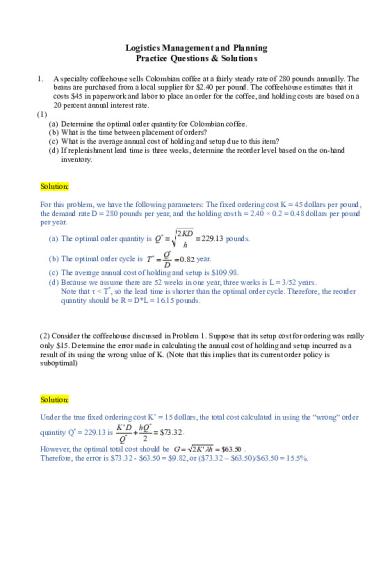Exam 5 November, questions and answers PDF

| Title | Exam 5 November, questions and answers |
|---|---|
| Course | Operations Management |
| Institution | 香港科技大學 |
| Pages | 14 |
| File Size | 488.1 KB |
| File Type | |
| Total Downloads | 45 |
| Total Views | 426 |
Summary
Logistics Management and Planning Practice Questions & Solutions 1. A specialty coffeehouse sells Colombian coffee at a fairly steady rate of 280 pounds annually. The beans are purchased from a local supplier for $2 per pound. The coffeehouse estimates that it costs $45 in paperwork ...
Description
Logistics Management and Planning Practice Questions & Solutions 1.
A specialty coffeehouse sells Colombian coffee at a fairly steady rate of 280 pounds annually. The beans are purchased from a local supplier for $2.40 per pound. The coffeehouse estimates that it costs $45 in paperwork and labor to place an order for the coffee, and holding costs are based on a 20 percent annual interest rate.
(1) (a) (b) (c) (d)
Determine the optimal order quantity for Colombian coffee. What is the time between placement of orders? What is the average annual cost of holding and setup due to this item? If replenishment lead time is three weeks, determine the reorder level based on the on-hand inventory.
Solution: For this problem, we have the following parameters: The fixed ordering cost K = 45 dollars per pound, the demand rate D = 280 pounds per year, and the holding cost h = 2.40 × 0.2 = 0.48 dollars per pound per year. 2KD (a) The optimal order quantity is Q* = = 229.13 pounds. h Q* (b) The optimal order cycle is T * = = 0.82 year. D (c) The average annual cost of holding and setup is $109.98. (d) Because we assume there are 52 weeks in one year, three weeks is L = 3/52 years. Note that τ < T*, so the lead time is shorter than the optimal order cycle. Therefore, the reorder quantity should be R = D*L = 16.15 pounds.
(2) Consider the coffeehouse discussed in Problem 1. Suppose that its setup cost for ordering was really only $15. Determine the error made in calculating the annual cost of holding and setup incurred as a result of its using the wrong value of K. (Note that this implies that its current order policy is suboptimal)
Solution: Under the true fixed ordering cost K’ = 15 dollars, the total cost calculated in using the “wrong” order K ' D hQ* + quantity Q* = 229.13 is = $73.32 . 2 Q* However, the optimal total cost should be G' 2K' h $63.50 . Therefore, the error is $73.32 - $63.50 = $9.82, or ($73.32 – $63.50)/$63.50 = 15.5%.
2.
Next week, Super Discount Airlines has a flight from New York to Los Angeles that will be booked to capacity. The airline knows from past history that an average of 25 customers (with a standard deviation of 15) cancel their reservation or do not show for the flight. Revenue from a ticket on the flight is $125. If the flight is overbooked, the airline has a policy of getting the customer on the next available flight and giving the person a free round‐trip ticket on a future flight. The cost of this free round‐trip ticket averages $250. Super Discount considers the cost of flying the plane from New York to Los Angeles a sunk cost. By how many seats should Super Discount overbook the flight?
Solution: Cu = $125 Co = $250 P(D...
Similar Free PDFs
Popular Institutions
- Tinajero National High School - Annex
- Politeknik Caltex Riau
- Yokohama City University
- SGT University
- University of Al-Qadisiyah
- Divine Word College of Vigan
- Techniek College Rotterdam
- Universidade de Santiago
- Universiti Teknologi MARA Cawangan Johor Kampus Pasir Gudang
- Poltekkes Kemenkes Yogyakarta
- Baguio City National High School
- Colegio san marcos
- preparatoria uno
- Centro de Bachillerato Tecnológico Industrial y de Servicios No. 107
- Dalian Maritime University
- Quang Trung Secondary School
- Colegio Tecnológico en Informática
- Corporación Regional de Educación Superior
- Grupo CEDVA
- Dar Al Uloom University
- Centro de Estudios Preuniversitarios de la Universidad Nacional de Ingeniería
- 上智大学
- Aakash International School, Nuna Majara
- San Felipe Neri Catholic School
- Kang Chiao International School - New Taipei City
- Misamis Occidental National High School
- Institución Educativa Escuela Normal Juan Ladrilleros
- Kolehiyo ng Pantukan
- Batanes State College
- Instituto Continental
- Sekolah Menengah Kejuruan Kesehatan Kaltara (Tarakan)
- Colegio de La Inmaculada Concepcion - Cebu















